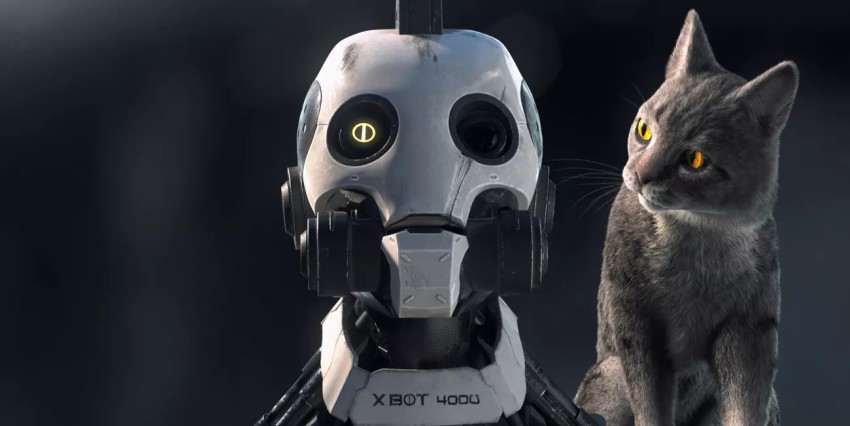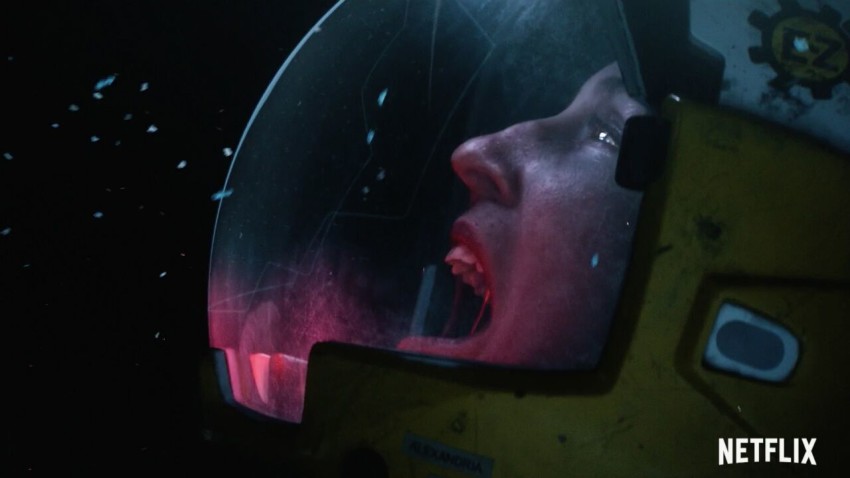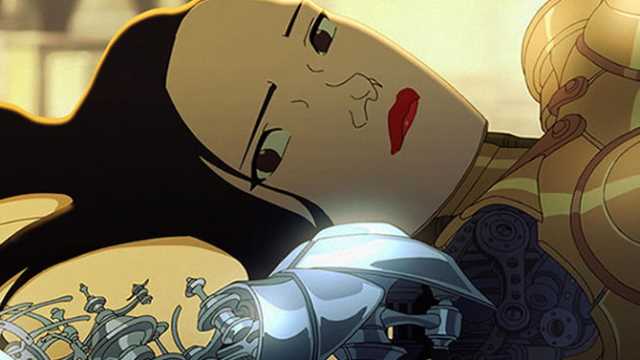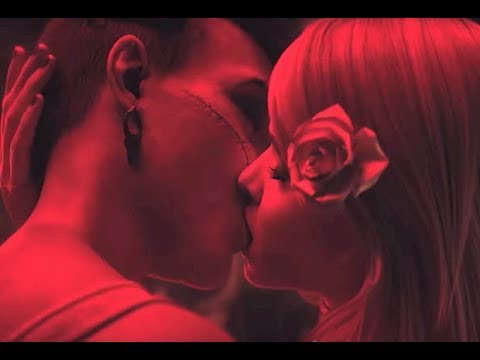Love, Death & Robots
March 16, 2019 · 2 comments
By Andrew Osmond.
 Just out on Netfix, Love Death & Robots isn’t an anime series, but it takes Western adult animation down paths blazed by anime decades ago. It’s an anthology, with eighteen short episodes, mostly between ten and fifteen minutes each. Unlike Black Mirror, there’s no linking theme or style in stories which mix SF, fantasy and horror. You’ll find mecha and space travel, but also werewolves, vampires and fox spirits.
Just out on Netfix, Love Death & Robots isn’t an anime series, but it takes Western adult animation down paths blazed by anime decades ago. It’s an anthology, with eighteen short episodes, mostly between ten and fifteen minutes each. Unlike Black Mirror, there’s no linking theme or style in stories which mix SF, fantasy and horror. You’ll find mecha and space travel, but also werewolves, vampires and fox spirits.
About a third of the stories are comedies, often black in tone. Others are rhapsodies, tragedies and nightmares. Many are adapted from short stories by prose fiction heavyweights – see below. They’re frequently sweary, and often have very explicit violent and sexual content. If you’ve seen the series’ trailer – described by the Verge’s Tasha Robinson as a “manic headache” – you may have thought of The Animatrix, or even the heavy metal “Manga” ad which defined anime’s image in Britain in the early 1990s. In fact, Love, Death & Robots is less anime-ish than you’d expect, though there are clear influences here and there.
Moreover, while the publicity highlights two of the series’ exec producers, Tim Miller (director of Deadpool) and David Fincher (director of Seven, Fight Club and Gone Girl), it’s hard to see much tie-in with their famous works. However, both have been long linked to adaptations of major SF books. Fincher’s Rendezvous with Rama seems dead but Miller’s Neuromancer might yet be made. Plainly, they like the territory.
Love, Death & Robots is a good series, occasionally excellent. Given that the episodes can be seen in any order, I’d suggest not following the numbering, as the later episodes tend to be stronger. I’d actually begin with one of the middle episodes, “Helping Hand” (part 11). It starts like Gravity, with a woman astronaut tumbling through space, but there’s no male savior like George Clooney and the payoff’s very different.
The crisis in the story is caused by a stray nail, some debris from a past space project, which strikes the woman’s jetpack. The image of the nail hurtling through space is extremely close to one of the first images in a brilliant anime space drama, Planetes – due for future release by Anime Limited – and may be a deliberate homage.
 “Helping Hand” looks like Gravity rather than Planetes. After watching it, I recommend going on to the next episode, “Fish Night” (part 12). It’s a glorious “drawn” story about two men stranded on a desert highway and their encounter with the ghosts of prehistory. The lyricism reminded me of wonder stories such as Ray Bradbury’s classic “The Fog Horn,” which inspired the film Beast from 20,000 Fathoms, which in turn helped inspire Godzilla.
“Helping Hand” looks like Gravity rather than Planetes. After watching it, I recommend going on to the next episode, “Fish Night” (part 12). It’s a glorious “drawn” story about two men stranded on a desert highway and their encounter with the ghosts of prehistory. The lyricism reminded me of wonder stories such as Ray Bradbury’s classic “The Fog Horn,” which inspired the film Beast from 20,000 Fathoms, which in turn helped inspire Godzilla.
Actually, “Fish Night” is based on a story by a different feted author, Joe R. Lansdale. His original story is available online; you can spot how the animated version makes a crucial change at the end. Another lyrically drawn and written episode is “Zima Blue” (part 14), from a story by British author Alastair Reynolds. It’s a fable about a great artist of the cosmos who finds a surprise apotheosis; its comment on transhumanism would amuse Mamoru Oshii.
 From an Asian perspective, the most interesting episode is part 8, “Good Hunting.” This could pass as anime visually, but the setting is nineteenth-century China (plus a British-colonised Hong Kong), and it was made by a South Korean studio, Red Dog Culture House (showreel here).
From an Asian perspective, the most interesting episode is part 8, “Good Hunting.” This could pass as anime visually, but the setting is nineteenth-century China (plus a British-colonised Hong Kong), and it was made by a South Korean studio, Red Dog Culture House (showreel here).
“Good Hunting” has a fox-spirit seductress and a glimpsed erect penis that wouldn’t have got into adult anime. The film pushes sex and violence almost as close together as the most notorious hentai titles, and some viewers may find it odiously misogynist. But it’s a strong vision, sliding from wuxia and eroticism into steampunk and anti-colonialism. Again the source story is online; the author is Ken Liu (named on the credits as “Kenneth”), who’s profiled by Joanthan Clements here.
Then I’d go to the first episode, “Sonnie’s Edge.” Similar in some ways to “Good Hunting,” it’s a story of monstrous tournaments in London’s East End. There are Game of Thrones levels of violence and sex, a compelling protagonist and an angrier feminist message than Captain Marvel. That’s a surprise, given the source story is by Peter Hamilton, who’s not universally acclaimed for his treatment of women characters.
 After that, I’d try the last episode, “The Secret War” (part 18). Set in the great Russian wilderness, it has hokey demon monsters but also some moving human moments amid the Lean-meets-Lovecraft spectacle. It was animated by Digic Pictures in Hungary. Both “Sonnie’s Edge” and “Secret War” are made in mocapped CG animation, of the kind familiar to players of Call of Duty or Assassin’s Creed.
After that, I’d try the last episode, “The Secret War” (part 18). Set in the great Russian wilderness, it has hokey demon monsters but also some moving human moments amid the Lean-meets-Lovecraft spectacle. It was animated by Digic Pictures in Hungary. Both “Sonnie’s Edge” and “Secret War” are made in mocapped CG animation, of the kind familiar to players of Call of Duty or Assassin’s Creed.
The same style is used for “Shape-Shifters,” (part 10) in which the US army deploys werewolves in Afghanistan. It’s not so different in concept from the first Blood The Last Vampire film, where Americans let a demi-human monster loose in an army base.
There are more military themes in “Lucky 13” (part 13). It’s a good otherworld action-adventure. The road-heist actioner “Blindspot” (part 15) is another could-be-an-anime, made by a Russian director (Vitaliy Shushko) and a Californian studio. It’s slick and fun, but forgettable.
More engaging is “Suits” (part 4), an adventure story that uses the same “jerky CG” approach as Spider-Man: Into the Spider Verse, mostly successfully. The imagery of heroes struggling against a horde of alien bugs homages the alien bug epic, Starship Troopers. “Suits” comes complete with the title mecha vehicles, which were in the Heinlein Troopers novel but not the live-action Verhoeven film
The comedic episodes include a trio of CG tales based on John Scalzi stories, and a world-in-a-fridge yarn from Michael Swanwick. (They’re episodes 2, 6, 17 and 16.) Actually, all the episodes in the series are worth a look, though the lesser ones can be tiresomely reliant on swearing, gore and mostly female nudity.
It says something that even in 2019, a Western adult animation leans on such things to prove it’s adult. The excess swearing recalls some early anime dubs that added profanity for cred with the audience. The other tendencies, however, predate Akira. 1981’s Heavy Metal, another adult animated anthology, was consumed by its obsession with gore and nudity, making it barely watchable for anyone outside its narrow demographic. A decade ago, Fincher and Miller were actually involved in an attempted animated remake of Heavy Metal, but it was never made.
 Love Death & Robots is far better than Heavy Metal in all departments, yet the same malaise infects it. It’s doubly unfortunate, as the mix of styles seem to be a bid to stretch viewers’ ideas of animation, though the styles themselves are no more diverse (perhaps less) than anime anthologies like Genius Party. But in Love, Death & Robots, the episodes that are “overtly” animated, like “Good Hunting,” rub against episodes that will have viewers responding, “But that’s special effects, not animation!” or “But that’s not a cartoon, it’s a game!”
Love Death & Robots is far better than Heavy Metal in all departments, yet the same malaise infects it. It’s doubly unfortunate, as the mix of styles seem to be a bid to stretch viewers’ ideas of animation, though the styles themselves are no more diverse (perhaps less) than anime anthologies like Genius Party. But in Love, Death & Robots, the episodes that are “overtly” animated, like “Good Hunting,” rub against episodes that will have viewers responding, “But that’s special effects, not animation!” or “But that’s not a cartoon, it’s a game!”
As I mentioned, the“Helping Hand” episode riffs openly on Gravity, a film which especially blurred the line between “effects” films and animation. Then there’s the mo-capped animation in multiple episodes, which many Western viewers now see as being the preserve of games. That’s especially strange, given how much mocap has triumphed as an effects tool in Hollywood. In just the last few weeks, we’ve had Alita: Battle Angel’s huge-eyed heroine and the rejuvenated Nick Fury in Captain Marvel, both triumphs of mocap.
Yet “animated” mocapped films struggle for credibility in America and Britain, stymied by financial disasters like Final Fantasy: The Spirits Within and Mars Needs Moms. In contrast, the style is accepted in high-profile anime, such as Polygon Pictures’ Ajin – see from 1-30 in this clip.
The old Animatrix anthology included a single mo-capped film, but it felt discontinuous with the others, an odd one out. What’s different about Love, Death & Robots is that it puts all-mo-capped films together in a series with Gravity-style effects films and adult cartoons like “Good Hunting,” all presented as a continuum.
Where could it lead, if anywhere? Netflix has the series tagged as “Season 1” but we don’t know if any more have been ordered yet. Perhaps Netflix will measure the popularity not just of the whole series but of individual episodes – though inevitably the first numbered episodes will get more play than the others.
I’d certainly be interested in seeing more mocapped stories like “Sonnie’s Edge” and “Secret War,” as much as seeing more anime-ish works like “Good Hunting.” Love, Death & Robots has enough good episodes to be worthwhile in itself. But in today’s media multiverse, it’s impossible not to already wonder where it might lead.
Andrew Osmond is the author of 100 Animated Feature Films.
[ERRATUM: In the above review, I originally claimed that two of the episodes, Helping Hand and Lucky 13, use real actors amid virtual surroundings. In fact, it appears from the credits and from other reports that all the characters in these episodes, including their respective female leads, are entirely motion-captured. Apparently the only episodes which do use live actors are the Ice Age story and, by all appearances, The Witness. Mea culpa for the mistake, and hats off to the tech teams for fooling me so completely. — AO]
codesnik
March 23, 2019 10:05 am
authors of Witness claim not only that all is rendered, but also that they used keyframe animation only, not motion capture. https://www.instagram.com/p/BvNRIEOB1bd/ insane.
andrew osmond
March 24, 2019 7:21 am
Many thanks for the link! Well, having been already fooled by two other episodes, I've given up my right to judge, but... really? If so, it's brilliant, a remarkable achievement. But I would have thought that it was also rather impractical, except as a stunt to impress other people in the animation industry. Wouldn't it have been _easier_ to use live-actors? Maybe the artists' next challenge would be to see how convincingly they can use their keyfame animation to recreate an already famous actor, and see it they can get better results than recent Hollywood blockbusters. That would be a godsend when film-makers had to do reshoots and the original actors aren't available - Gladiator, The Crow and the next Star Wars sequel are obvious past examples.